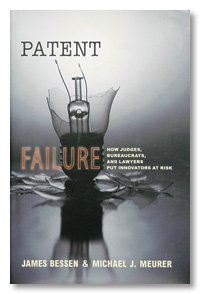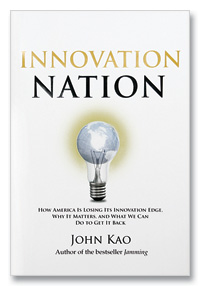Best Business Books 2008: Innovation
Chasing Breakthroughs
 Gina C. O’Connor, Richard Leifer, Albert S. Paulson, and Lois S. Peters
Gina C. O’Connor, Richard Leifer, Albert S. Paulson, and Lois S. Peters
Grabbing Lightning: Building a Capability for Breakthrough Innovation
(Jossey-Bass, 2008)
Don Tapscott and Anthony D. Williams
Wikinomics: How Mass Collaboration Changes Everything, expanded ed.
(Portfolio, 2008)
James Bessen and Michael J. Meurer
Patent Failure: How Judges, Bureaucrats, and Lawyers Put Innovators at Risk
(Princeton University Press, 2008)
John Kao
Innovation Nation: How America Is Losing Its Innovation Edge, Why It Matters, and What We Can Do to Get It Back
(Free Press, 2007)
It is somewhat mystifying, and maybe even a little discouraging, that several decades into the age of information we still talk constantly about the urgent need for innovation, yet managers struggle mightily to move good ideas from the lab bench to the marketplace. That’s not to say innovating can’t be done — the last I checked, IBM had racked up about 38,000 patents over the past 15 years, and Big Blue continues to stake out and commercialize intellectual properties with formidable speed and aggression. But how can the rest of the business world replicate such performance on a smaller, speedier scale? And how can a company like IBM itself keep up such a torrid pace? Year after year, most organizations struggle with the same daunting questions: What is the relationship between innovation and long-term growth? Should a company dedicate more resources to small innovations, or to something potentially explosive? Is the secret of successful R&D in the ideas, or is it in the execution? Is the spark to be found inside the company, or is it better sought on the outside?
This year’s four best books on innovation might help answer those questions. At first glance, they appear to have little in common. Each tackles a distinct aspect of the innovation game; they differ in substance as well as in sensibility. Moreover, they are aimed at different audiences — managers, lawyers, engineers, entrepreneurs, policymakers, marketers. This is, however, part of their combined value. We tend to think of innovation as a pursuit that requires technical ingenuity, hard work, and good management, as well as a splash of good luck. But the development of new products and processes also depends on public policies, legal environments, cultural paradigms, and the vagaries of the consumer marketplace. No single book discussed here will tell you everything you need to know about innovation circa 2008. Together, though, this year’s best books on innovation form an arresting and informative quartet. They confirm that innovation is a subject of considerable breadth and complexity that we should not take lightly or regard narrowly.
 A Breakthrough Capability
A Breakthrough Capability
In many respects, Grabbing Lightning: Building a Capability for Breakthrough Innovation keeps company with more conventional texts on innovation — the kind that speak with flowcharts and case studies to corporate managers who are trying to turn ideas into blockbuster businesses. This isn’t a criticism. Authors Gina C. O’Connor, Richard Leifer, Albert S. Paulson, and Lois S. Peters, all of whom are affiliated with Rensselaer Polytechnic Institute in upstate New York, have drawn upon several years of research involving some premier global corporations, including IBM, 3M, DuPont, and GE. Their research, which evaluates various companies’ successes and failures at systematizing their innovation capabilities, comes across as authoritative — even as it challenges the prevailing wisdom that startups have an inherent advantage over big, slow-moving firms.
“Many authors claim that established companies are unable to successfully commercialize breakthroughs,” they write, “but the fact is that companies have not dutifully tried.” This author team argues that most organizations can do better in creating institutional processes by which they can go about innovating.
Also, companies should learn to think big. Grabbing Lightning makes a critical distinction between ordinary innovation, which has been characterized by others as incremental or sustaining innovation, and breakthrough innovation, game-changing advances that alter the market and the fortunes of the company that creates them. The ability to produce breakthrough innovation is “the next major management capability large companies will claim as their priority,” the authors predict, “much like the quality effort was claimed in the 1980s.”
Many large organizations — not just IBM, GE, and Hewlett-Packard — are indeed moving in this direction, naming chief innovation officers, for example, or unveiling intriguing incubation strategies to foster worthy (and often risky) ideas. What should the leaders of these large organizations be doing? According to the authors, they should not be building skunkworks where geniuses eat junk food in splendid isolation, 24/7. Nor should they be depending on a lone, authority-bucking visionary who has an IQ of 200 but doesn’t understand the word “no,” or a dedicated internal venture group that has never seen an idea it didn’t want to grab and spin off. And most important, they shouldn’t sink a fortune into research and development. “We found no relationship between R&D expenditures as a percentage of sales and innovativeness,” the authors report, much to this reader’s surprise. (For more on innovation spending and effectiveness, see “Beyond Borders: The Global Innovation 1000,” by Barry Jaruzelski and Kevin Dehoff, s+b, Winter 2008.)
The secrets to breakthrough innovation, the authors advise, are more mundane: Build a permanent capacity for it within your organization and assign this challenge to a new, independent division so as to distinguish it from new product development. Organize the process in a way that can consistently nurture and deliver big ideas — in the authors’ conception, a “DNA” system of Discovery, iNcubation (yes, they took liberties with the N), and Acceleration into the marketplace. Also, don’t cut funding in a tough fiscal year, no matter how tempting the idea may be. Breakthrough innovations take a long time, so it’s best not to operate under the illusion that it is going to be easy. The authors admit that “the shape of the ultimate market is usually unclear; which applications will gain market acceptance most quickly and fully is generally unknown, and the path forward is, in many cases, difficult to visualize.”
This book may be a good tool in diminishing such uncertainties. The chapters on the incubation and acceleration of breakthrough technologies, in particular, offer a range of insights on how to overcome the difficulties of the commercialization process. A quibble is that Grabbing Lightning could be more compact; some of the chapters mutate into subsections and sub-subsections that can cause readers to lose their bearings. Still, the book is noteworthy for two reasons: the care with which the authors have created a road map for boosting the innovative capacity of big business, and their daring suggestion that an era of corporate-driven breakthroughs is at hand. The train is now leaving the station, they seem to be saying. Time to get on board.
Reaching Out
One of the more intriguing details within Grabbing Lightning is that all of the large companies in the authors’ study group now make use of the open innovation model — that is, they willingly look beyond their own organization for the best ideas, opportunities, and partners. A few years ago, academic and writer Henry Chesbrough coined the term open innovation in a book of the same name. Don Tapscott and Anthony D. Williams’s Wikinomics: How Mass Collaboration Changes Everything further explores the concept by considering how today’s vast communications networks can support open innovation. Another way to say this is that the Internet, and especially the newest iterations of the Web (often termed Web 2.0), have permanently altered the process and potential of innovation.
According to the authors, both executives at the strategy group New Paradigm, companies will compete in the 21st century by being more open to outside partnerships, more reliant on collaborative idea generation, less protective of their intellectual property, and wholly global in their outlook. The old model for corporations — insular, hierarchical, and paranoid — is rapidly becoming outmoded. The new model harnesses the insights of customers and business partners to improve (or, even better, to create) its products and services. “Increasingly,” the authors note, “you should assume the best people reside outside your corporate walls.”
Wikinomics is by no means wikiperfect. It is a testament to the rapidity of the Web’s evolution, as well as to the speed of its cultural penetration, that some of the authors’ observations on virtual destinations like MySpace already seem dated (indeed, the 2008 edition updates a book that was originally published less than two years ago). In addition, the book’s enthusiasm about projects like the Boeing 787 seems unwarranted in light of that jet’s serial delays, most of which are precisely a result of its collaborative production process. More problematic still are the breathless claims in the book’s early chapters (“collaboration on a mass scale is set to change every institution in society”; “we are witnessing the reweaving of the social, political, and economic fabric that binds our planet”) that threaten to undermine the authors’ arguments before they even have a chance to put them forward.
Yet when the authors do get down to specifics — in discussing IBM’s adaptation of the Linux operating system, for instance, or the promise of a Web site like InnoCentive, which matches independent innovators with companies seeking help on specific problems — their arguments are astute and nuanced. And clearly, Wikinomics is on to something very big that any entrepreneur or manager would do well to understand. The book’s substantial achievement is not only in explaining how new businesses like Flickr, Second Life, or YouTube have succeeded by collaboration, but in exploring how collaborative processes yield results that seem to surpass the capability of individual efforts. In the case of Best Buy’s Geek Squad, for instance, employees from around the country now trade tips and share field reports in the course of playing online games like Battlefield 2, a process the division’s managers deem far more effective — and fun — than a more formal, top-down information transfer.
With the Web still in its infancy, it remains unclear how far collaborative models can push the innovation process. What if pharmaceutical research, the authors wonder, became an open pursuit? Could we then make collective headway on intractable diseases that have flummoxed the industry? The authors rightly note that wikinomics is not a panacea; simply looking outside your company for good ideas, for instance, cannot make up for shortcomings like bad internal management. And relying on outside input does not mean that corporations should immediately open their books and unburden themselves of trade secrets. But according to Wikinomics, companies will certainly need to move at least a few steps in that direction, and perhaps a whole lot more. In the words of the authors: “The choice facing firms is not whether to engage and collaborate with peer-production communities, but to determine when and how.”
 Patently Ineffective
Patently Ineffective
The problem with a whirring, blinking, interconnected, electronic world — where information is rapidly disseminated, shared, swapped, and improved — is that it comes into natural tension with privacy and intellectual property rights. The current patent system is ailing, say James Bessen and Michael J. Meurer, both legal academics based at Boston University and the authors of Patent Failure: How Judges, Bureaucrats, and Lawyers Put Innovators at Risk. It is time, they argue, to figure out how we can reward inventors for their work without putting fences around new research that restrict social and scientific progress.
In Patent Failure, Bessen and Meurer examine the U.S. patent system’s current procedural and operational shortcomings. Considering the book’s titular promise to reveal the dangers posed by judges, bureaucrats, and lawyers, readers might expect an angry broadside leveled at the entire legal profession. On the contrary, Patent Failure is measured and methodical, a provocative, evidence-based book for the lawyer and entrepreneur alike. The authors are nothing if not reasonable men.
The heart of their argument rests on exploring the distinctions between patents and property. The patent system, the authors maintain, isn’t broken and doesn’t need to be discarded. But it needs some serious improvements. Consider the suit brought by the so-called patent troll holding company, NTP Inc., against Research In Motion (RIM, maker of the BlackBerry), in which NTP charged that RIM had infringed upon its old software patents for wireless e-mail. Bessen and Meurer note that RIM executives were not aware of NTP’s patents until early 2000 — “ten years after RIM started developing wireless technology, four years after RIM introduced its prototype of the BlackBerry.” The suit nevertheless resulted in RIM paying out US$612.5 million.
“Increasingly, patents fail to provide clear notice of the scope of patent rights,” the authors explain. “Thus, innovators find it increasingly difficult to determine whether a technology will infringe upon anyone’s patents, giving rise to inadvertent infringement.” Unlike property such as land, with which boundaries are distinct and deeds are clear, the topography of intellectual property is in places so ill-defined and treacherous that innovators, and would-be innovators, can easily be discouraged. The authors’ analysis of recent data, for instance, suggests that the cost of patent litigation falls on innovators, thus creating a disincentive to innovate.
Bessen and Meurer conclude that the patent system still works fairly well for the chemical and pharmaceutical industries. It comes up short, though, in software, where abstractions cloud patent claims and invite confusion and litigation. The authors identify the system’s problems as a relatively new phenomenon — one that most likely began in the late 1980s, which happened to be when a profusion of software claims began to be awarded. Patents might work better in the pharmaceutical industry, they conclude, because such patents have sharper boundaries than patents on software.
Of course, what we really want to know is how to fix all this. Patent Failure puts forward a number of suggestions, all explained in greater detail than this space allows. To start with, the U.S. could use a system of specialized patent courts presided over by judges who have special familiarity with patent issues (currently patent suits can be tried in any federal district court). Other changes need not be so expensive. At the U.S. Patent and Trademark Office itself, examiners need to “reject vague and abstract claims more aggressively.” Another crucial fix could preempt the fuzzy-boundary problem: The patent office should be able to issue upon request an “infringement opinion letter.” Thus the authors envision a new system where “any party can approach the agency and request its opinion about whether a particular technology infringes upon a U.S. patent.” That sounds like a sensible idea, as does their suggestion for raising patent fees to stem the flood of applications coming into the patent office. Knowledgeable readers may find themselves thinking up other, or better, solutions. But it’s hard to disagree that we need to start considering how the law can better help, and not hinder, our inventors. Innovation is hard enough as it is.
 An Innovation Agenda
An Innovation Agenda
Whether we will find ways for big corporations to nurture breakthrough innovations; whether we can make better use of collaborative global networks; whether we should improve on our patent system — all these questions figure into the larger issue of why innovation matters, and how we can get more of it in the years to come. Innovation Nation: How America Is Losing Its Innovation Edge, Why It Matters, and What We Can Do to Get It Back, by John Kao, explores why the U.S. should act quickly to preserve its eminence in new ideas and technologies. The country is now in danger, the author believes, of being surpassed in its inventive capacity not only by China and India, but by Denmark and Finland and a host of other nations.
Kao, the chairman and CEO of the strategy firm Kao & Company and a former professor at Harvard Business School, has written a readable, passionate, and occasionally distressing book. Aimed at the U.S., it could also be applicable to the policymakers, research shapers, and business leaders of any other nation. The book doesn’t speak directly to the scientist at his or her bench, nor does it say, precisely, what innovation can do for a company’s bottom line. Yet it does an admirable job of explaining why innovation figures so importantly in the forward march of civilization, and is my pick for best innovation book of the year. Clearly, Kao believes that the future of the United States is riding on innovation. “In what way can we mature the American idea?” he asks. What we need, he answers, is a renewed and evolved sense of purpose — “a new national narrative,” in his felicitous description — centered on the pursuit of innovation.
Kao’s agenda may petrify small-government types. He nevertheless makes his case forcefully, urging for a reinvigorated federal role, one reminiscent of the Apollo program or Manhattan Project, in funding a national infrastructure for innovation — $20 billion to start, distributed to 20 innovation “hubs” around the country. Each hub could focus on a particular area such as cleantech or agriculture or digital media. Kao argues that such hubs, which should resemble venture capital–like incubators rather than regimented government bureaus, could be just as fruitful for the U.S. as they’ve been for, say, Singapore, whose efforts he extends as a prime example of how government can nurture an innovation engine in biotechnology.
Kao undoubtedly thinks the U.S. has little choice but to pursue such a major investment if its leaders want to compete in the global marketplace. Other countries are churning out world-class scientists who would now rather study and work in their native countries than come to the U.S. Meanwhile, some of the United States’ own best thinkers have been lured abroad to places like Singapore by the promise of ample financial resources and the freedom to pursue their research ideas. Should the U.S. government fail to pursue an agenda of innovation, Kao warns, “at some point — sooner than we might think — the curves of our decline and the rest of the world’s ascent will cross.”
Though Kao sounds some alarmist notes, his book has a largely optimistic feel. And he never seems to question whether the U.S. has the capability to take the lead in solving the world’s most difficult problems, such as poverty, cancer, or climate change. What irks him is the rapidly growing divide between what the U.S. is actually achieving in terms of innovation, and what it could achieve if it adopted the right policies, priorities, and attitude. Be forewarned that this is a grand and audacious agenda for any nation. Then again, no innovator ever got anywhere by thinking small. ![]()
Author profile:
Jon Gertner is a contributing writer at the New York Times Magazine. He is currently writing a book for Penguin Press about the history of Bell Labs and the process of innovation.


